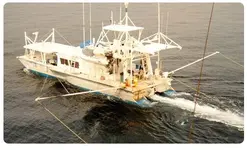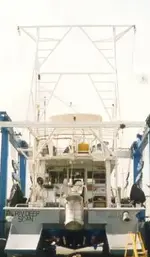Scuba,
You got the main point and problem. This particular record was taken with 5 differant frequency transmitted at the same time 3.5khz, 12khz,24khz,50khz and 200khz. The higher the frequency the shorter the wavelength the better the resolution. On the other hand the lower the frequency the better the bottom penetration but "blurrs the record" This is why we use so many frequency etc. They are combined in software signal processing to produce the best of both worlds......so goes the theory. Conventional chirp sonar sweeps threw a frequency band and is then processed so you get fractional wavelenght thus better resolution.....this is great in deeper water but in shallow water since you transmitted a longer pulse or sweep you get interference with shallow water data being overburdened by out going transmit pulse and many other problems, surface ghost, bottom multiple etc. I use this particular system for sediment, pipeline type surveys. We did find some ballast piles on a couple of projects. Used side scan etc after plotting the site. It is yet another tool for the tool box!
Best Regards
Scott





 Here's the boat specs
Here's the boat specs 

